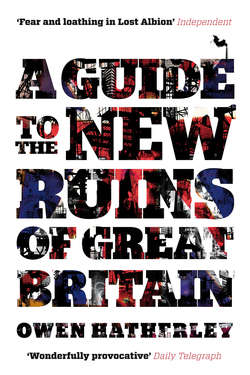A Guide to the New Ruins of Great Britain

Реклама. ООО «ЛитРес», ИНН: 7719571260.
Оглавление
Owen Hatherley. A Guide to the New Ruins of Great Britain
A GUIDE TO THE. NEW RUINS OF. GREAT BRITAIN
Contents
Introduction. The Change We See
Be Careful What You Wish For
Architecture Becomes Logo: The Rise of Pseudomodernism
Service Stations, Service Industry
In (Partial) Praise of Urban Britain
Chapter One. Southampton: Terminus City
In Search of Solent City
Eastern Dock
Western Dock
Shedscape
Chapter Two. Milton Keynes: Buckinghamshire Alphaville
A New Career in a New Town
The End of the Space Age
Chapter Three. Nottingham: The Banality of Aspiration
Bespoke Containers
‘An evangelical college without God’
Chapter Four. Sheffield: The Former Socialist. Republic of South Yorkshire
Complexity and Contradiction in Sheffield Modernism, Part 1: Castle Market
Complexity and Contradiction in Sheffield Modernism, Part 2—Park Hill
Replanning Sheffield—Hung, Drawn and Quartered
Culture Industry/Steel Industry
Chapter Five. Manchester: So Much to Answer For
Property Development as the new Punk Rock
Post-Rave Urban Growth Coalition
New Emerging Babylon
‘Up the tenth floor, down the backstairs, into no man’s land’
Green Brutalism
The Home of Credit Crunch Chic
The Bloxham Organization
Chimney Pots and Conran Interiors—The New Salford
Chapter Six. Tyneside: From Brasilia to Baltic
‘I have a terrible feeling we won’t be getting our fees on this one’
Our New Cathedrals
Regenerated or Dead
Exhuming the Brasilia of the North
Revolution via Quango
Chapter Seven. Glasgow: Looking for the Future. in All the Wrong Places
Service Stations between the Futurist and the Organic
Theme for Great Cities
Redoubt on the Clyde
From Film-Set Chicago to the Glasgow Bloc
The Tentative Enclaves of the New Glasgow Modernism
A Walk from the Past to the Future and Somewhere In Between
Into the Grid
Palaces for the People
Chapter Eight. Cambridge: Silicon Fences
The Pretence to the Proletarian
Hiding in Plain Sight
Scientists and Their Bloody Childish Living Habits
Chapter Nine. The West Riding: Instead of a Supercity
The Marketplace
‘“It’s like Hell, isn’t it?” he said enthusiastically’
Building Society Design
Local Architecture for Local People
Blake’s Seven, Leeds Nil
Best Among Ruins
Chapter Ten. Cardiff: Manufacturing a Capital
A Capital Done on Design and Build
Libraries Gave Us Power (and Concessions)
Chapter Eleven. Greenwich: Estuarine Enclaves
Greenwich’s Shifting Borders
The Pursuit of the Millennium—Greenwich Peninsula as a Blairite Tabula Rasa
A Good Idea, Fallen Among Fabians
Alternatives (1)—The Architecture of Climate Camp
Alternatives (2)—Greenwich Mural Workshop and London’s Hidden Socialist Realism
Are You Arsenal in Disguise?
Nil Scrap Value
What’s All This I Hear about a ‘New Way’?
Chapter Twelve. Liverpool: Exit
The Last Days of Municipal Socialism
The One Is Not
Over the Wall
Acknowledgements
Notes
General Index
Index of Places
Отрывок из книги
Praise for A Guide to the New Ruins of Great Britain
‘An excellent vade-mecum for the disgruntled urban flaneur.’ Keith Miller, Times Literary Supplement Books of the Year
.....
Several books guided this guide, principal among them one published in 1934, a travel book called English Journey by the Bradfordian writer J. B. Priestley.9 In the following decade it was so widely read as to become one of those semi-mythical books that ‘won the ’45 election for Labour’—a sharp, populist, politely angry account of a deliberate attempt to look England in the face, from Southampton to Newcastle. This book is consciously written in Priestley’s shadow, albeit extending it outside of the dubious centrality of England, and focused much more strictly on buildings rather than anecdote and general observation. A few others also cast a heavy shadow—the mid-century journeys of Ian Nairn, the 1990s dérives of Patrick Keiller—and what links all three, other than my (usually hidden) references to them here, is a disinterest in or critique of Heritage England, and the pervasive myth of either an overcrowded or a green and pleasant land.
By the mid nineteenth century, this was the only country in the world which had more urban than rural inhabitants. Even now, after a century of sentimentalism about the countryside, around 90 per cent of us live in essentially urban areas, and although around 70 per cent of the landmass is still agricultural land, only 300,000 people actually work it. This might be an urban island, but extraordinarily Penguin Books were able to release a set of twenty books in 2009 called English Journeys, in obvious reference to Priestley, every single one of which dealt with the countryside. The bulk of Priestley’s account was urban, this being where the overwhelming majority of the English lived. At the end of this survey of a country torn between north and south, rich and poor, Priestley listed three Englands that he had found on this journey, all of them embodied in their man-made structures. The first was the countryside, an area of patchwork fields and local stone, one which has ‘long since ceased to make its own living’, pretty in its desuetude, if over-preserved. The second was that of the Industrial Revolution, of iron, brick, smokestacks and back-to-backs, more ‘real’ than the first but ruthlessly inhumane towards its inhabitants. Last was a third, commercial world of arterial roads, Tudorbethan suburbia, art deco factories and cinemas; cheap and ersatz, but without the brutality of the second.
.....